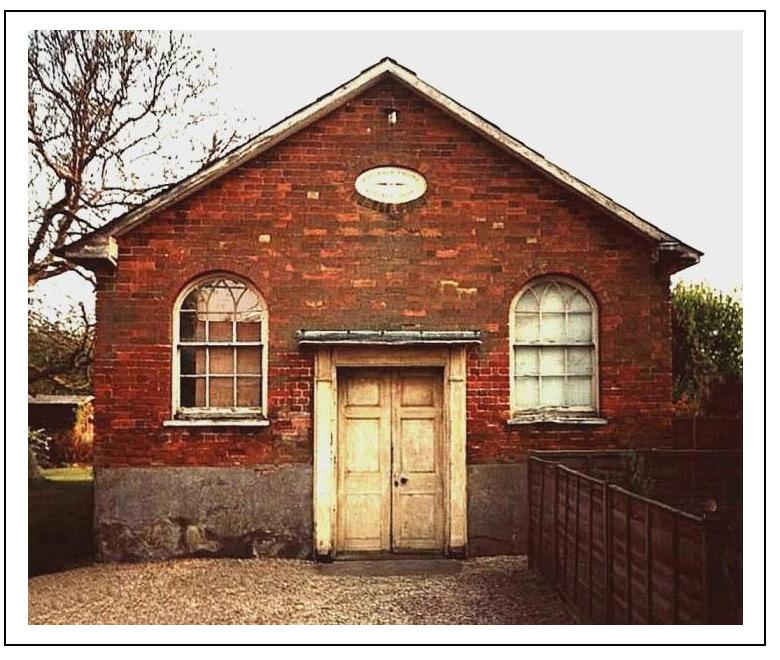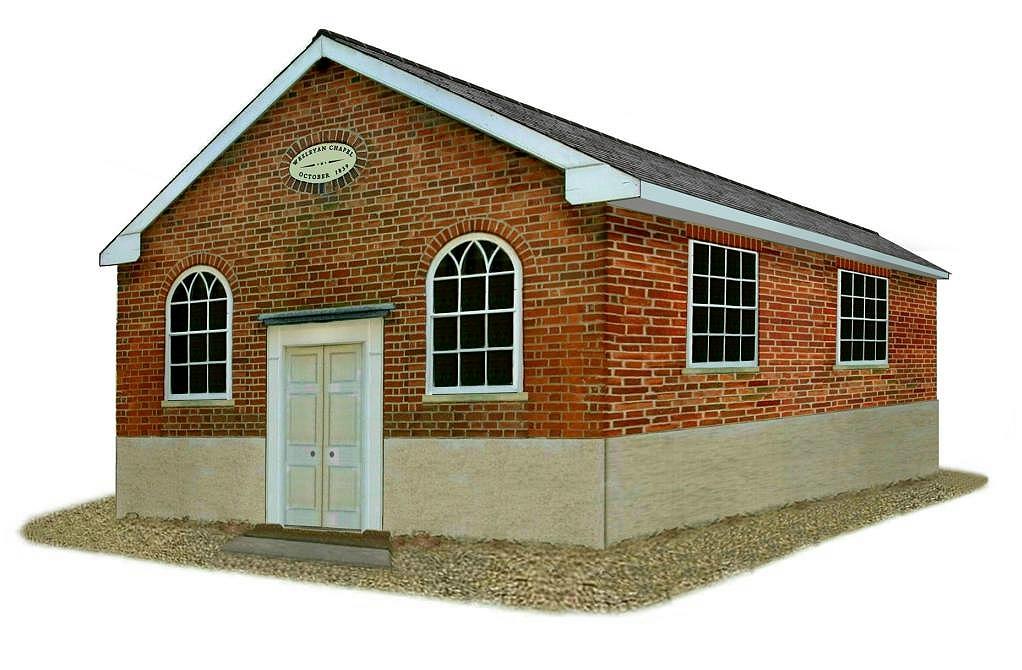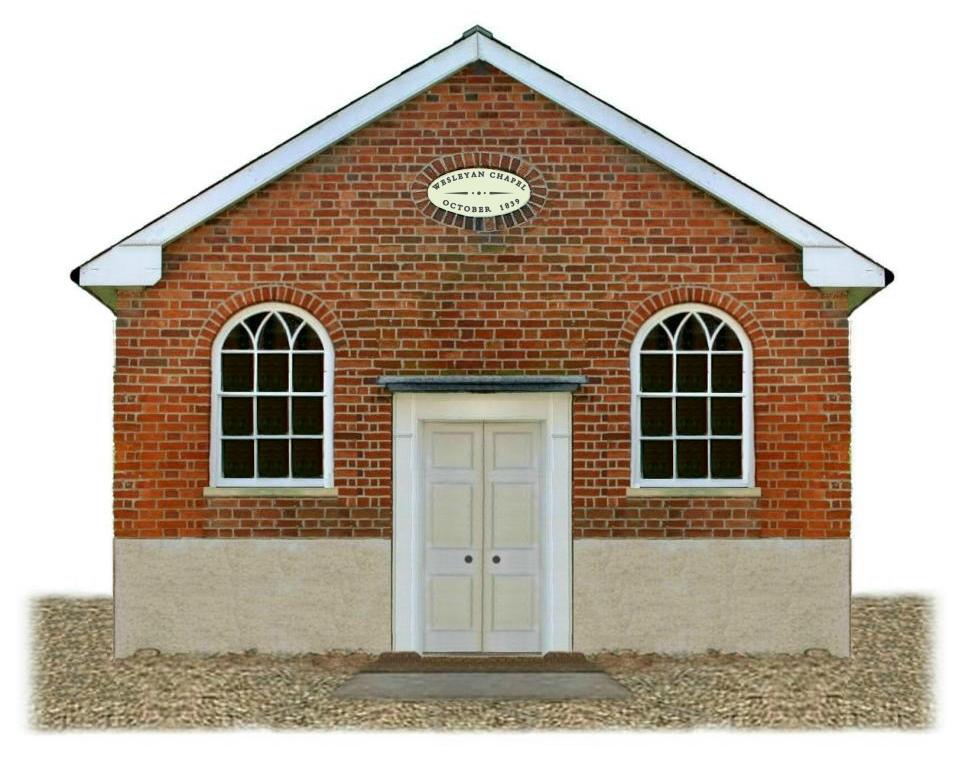The Wesleyan Chapel
The Chapel is set back between No’s 7 & 9 Head
Street and was built in 1839. It ceased to be a Methodist Chapel in 1967.
Chapel records of 1829 refer to 100 places of worship and later refer to 60
places. Although the Chapel has long since ceased to be a place of worship, the
building remains but was derelict for several decades. It has always been a Listed Building and in the early
days applications were made to convert it to for a commercial use, which were
opposed and rejected. For many years it has been part of the adjacent property,
and although remaining “standalone” it has been externally restored and
internally converted to become part of the residence.
Denis Chaplin recalled that the Chapel had
fitted pews either side of a central aisle facing a pulpit, which was raised on
a central dais. There was an American made reed organ on the left and an iron
stove on the other side. There was no altar or font. Oil lamps were used until
electricity arrived in the village 1937.
Some of the Goldhanger Friendly Brothers founders were
preachers at the Chapel and regular meetings were held there. Friendly Society
Rules of 1876 refer to meetings held "At a certain meeting place or
Wesleyan Chapel".
The Chapel was given a new
lease of life in the 1920s when Stanley Wilkin moved
to Bounds Farm, Goldhanger and became its ardent supporter and preacher.
"Happy" Sam Ruffles, who worked for Mr Wilkin, was also a preacher.
He was the Brass band leader and in the 1940s the Chapel was used by the Band.
Methodist Christenings can be remembered, but weddings and funerals were held
in Maldon. In the 1950s harvest festival services in the Chapel were followed
by sales of produce in the Village Hall. John
Wilkin played the organ their as a teenager.
“The Story of the Chapel in Goldhanger" was written in 1993 by Maura Benham
with the
help of John Wilkin...
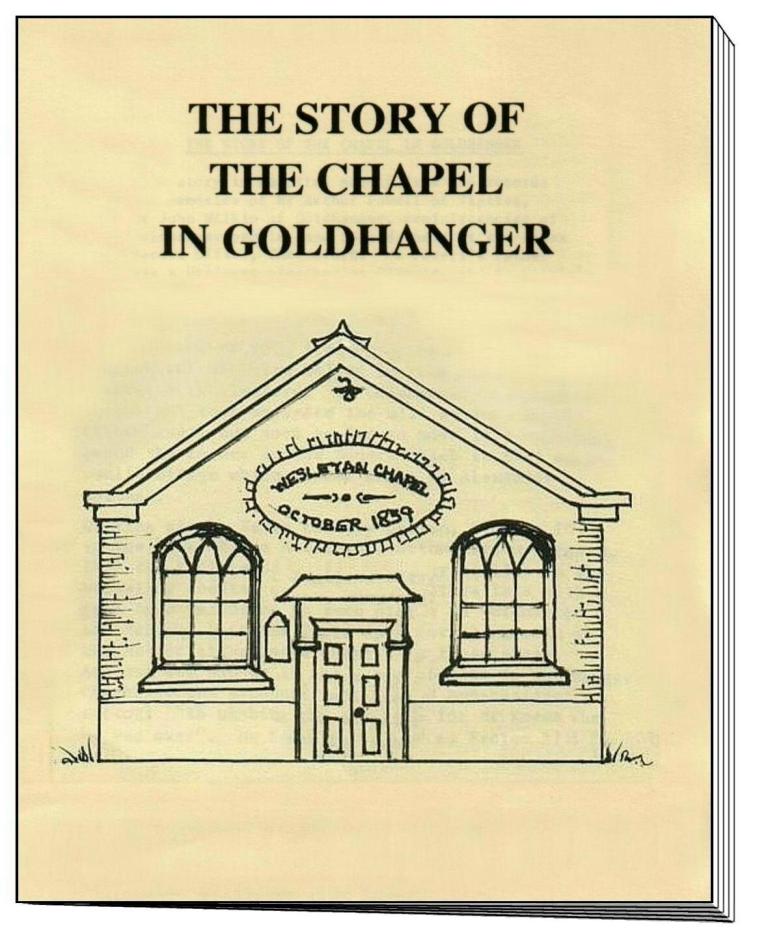
the 12-page booklet is
transcribed here...
This story is compiled mainly from the
records and memories of Mr Arthur Powell of Tiptree, Mr John Wilkin of
Goldhanger, reminiscences of Goldhanger people, and records held at the Essex
Record Office, Chelmsford. Mr Powell's father was a Wesleyan preacher on
Circuit, and Mr Wilkin's father played a prominent part in running the chapel
from 1926 to 1946. In 1807 a sheep dresser aged 29 named George Alexander came
from Wiltshire to Goldhanger. He was an uncompromising Methodist, preaching In
the villages and walking frequently to worship in Colchester. He also helped to
form the Wesleyan Society in Chelmsford. In Goldhanger he preached first in a
room opposite the mill at the top of Fish Street, but soon he had to move to a
building round the corner in the Square which in 1826 was a small cottage which
became known as Alexander Cottage.
Writing of the Essex country parson,
1700 to 1815, in the book "Essex Heritage", Arthur Brown suggests
that the failure of Anglican clergy to live in the unhealthy coastal areas,
many as pluralists with a good town residence in such places as Colchester and
Maldon, left the field open for the growth of the Methodist/Wesleyan chapels in
those areas. And one may wonder if the entry of 1768 in Goldhanger
Churchwardens accounts indicates a non-resident rector: "to washing the
surplice for Mr Keene when he was Over". Mr Keene Is listed as Rector 1765
to 1770.
George Alexander settled In Goldhanger
and married Sarah Harper of Althorne (an area better known for its Primitive
Methodists), and they had ten children, four of whom died In infancy or early
childhood. The Tithe Map of 1839 shows that they lived in the house which prior
to 1827 was known as Robkins and is now 6 Head Street. The eldest son John
married and had at least three children, one of whom died in Infancy. He is
recorded as a baker in Goldhanger in 1847, and one may wonder if he had the
bakery still remembered at the top of Fish Street which may well be the
building where his father first preached. In the census return of 1851 Sarah
Alexander, by then widowed, was living in Church Street with two daughters,
Sarah Ann and Ann. Another daughter Mary was living with the maltster Jacob
Belsham, a widower of 56, as his housekeeper. The next entry lists John
Alexander's family of wife and three children and his 13-year old brother
Charles with them. John's occupation was then entered as a shepherd.. It is not
clear whether the "entry "Church Street" relates also to Jacob
Belsham's and John Alexander's houses. The census of 1881 shows John as a sheep
dresser, aged 60, living in Head Street, "married" but with no entry
of wife. The tombstone in the churchyard commemorates John and Martha, but the
dates and much of the writing have become illegible.
George Alexander's work as a preacher
had spread and grown and was sufficiently established to appear on the Circuit
Plan in 1819. Twenty years later a chapel of 90 sittings was erected in the
centre of the village, just beyond the Square and behind some houses in Head
Street, The deed conveying the property was completed on lit October 1840, and
contained the following statement: ' "all that piece of land situated In
Goldhanger Street containing a length from North to South at each end thereof,
35 feet, and a breadth from East to West at each end 25 feet upon part of which
a chapel has been erected, and all that piece of ground or way Leading from the
high road to the said piece of land already described containing in length from
North to South from the cart way of the high road to the first described piece
of ground 60 feet (but from the fence on the greensward adjoining the said high
road to the said piece of ground 34 feet only) and in width 4 feet and which
said piece of ground intended to be surrounded and boarded on the east* west
and south by parts of ground called Levers retained by the said William
King." It would seem that the deed appointing trustees dated 1st October
1840 was not enrolled till 1st February 1842. The trustees of 1842 were
J.Belsham, J.Bentall, Wm,.King, I.Belsham, John Wood, Janes Bentall, James
Carter and Rev. J.Williams.
In these years both church and chapel
seem to have drawn Large congregations. The Quarter Session records of 1829
refer to a place in Goldhanger styling Itself "Independent
Methodists", with John Baker, the Wesleyan Minister, giving attendance as
100. The records of 1829 also mentions a group of Antinomians in Goldhanger.
For the church, the Rural Dean's report of 1841, giving a population figure of
496 as In 1831, and noting that this was in 108 families, answered the question
as to what proportion belonged to the church as "The Greater
Proportion". In a return made 10 years later it was- stated that
"Goldhanger Church contains 260 free and 80 other sittings. Congregation
varied from 260 to 300." Later in the century the building was also used
by the Friendly Society known as "The Good Intent whose Rules and
Regulations printed in 1870 state "Now held at a Certain Meeting House or
Wesleyan Chapel situated in Goldhanger Street."
The Annual Circuit Trustees Minute Book
of Chelmsford Methodist Circuit (the former Chelmsford Wesleyan Circuit) shows
a decision made on March 24th 1885 to form new Trusts in Maldon and Goldhanger:
"It was thought desirable that a new Chapel Trust should be formed at
Maldon and the Superintendent was requested to arrange for same. Resolved that
the Goldhanger Trust be formed as soon as possible and that the boundary line
be marked off." Those present were Rev. J.F.Morrison, in chair. Rev. Thos.
Horton, Messrs. Coleman, Coppin, Morton, Stratford, Freeman, Death, Bevis,
Leech, A.N.Morton, Pilchin. The' Goldhanger Trust was renewed on 20th July
1885, being comprised of Henry S.Coleman, Alfred G.E.Morton, Basil H.Harrison,
George Henry Coleman, James Rice Freeman, Thomas A.Death, Samuel F.Stratford,
Samuel Finch, Joseph Uisbey, John C.Frost, Alfred Wade.
The same minute book shows that in 1902
Goldhanger had all receipts in advance, and it was reported that ground had
been fenced in. In 1908 Goldhanger expenses included £14.18.7, the cost of
renovating the chapel. The Local Preachers Book shows changes in the time of
service. In March 1907 it was changed from 6 to 6.30p.m. during summer months,
and in December 1910 after long discussion it was decided that evening service
"be discontinued^ In the absence of Mr Todd and resumed on his
return". It was noted in March 1916 that Bro. Clarence "Woodyard of
Maldon showed distinct promise as a preacher. It was agreed that opportunities
should be given him to accompany the brethren to Goldhanger, and that he should
be encouraged in his ambition to preach, but in September it was decided that
evening service should be suspended (during the winter months) for the time
being due to the shortage of preachers, Goldhanger was retained in the Circuit
Plan of 1919, although it was reported there was no one to take charge. In June
1923 Mr Woodyard's offer to raise a Mission Band at Maldon to run a monthly
service at Goldhanger met with approval, and in September he reported that
"since the Mission Band work had been formed in Goldhanger there had been
a distinct improvement in the congregation and in its spiritual
temperature", He was thanked and it was proposed Chat this should
continue.
Nevertheless it seems that the chapel
was not prospering in 1923 when Mr Stanley Wilkin came: with his family to live
at Bounds Farm, He was a staunch Non-Conformist, but finding the church was the
leading light in the village he went there. However, it did not suit him, and
as he and the Rector were both men who held their views strongly, he turned his
attention to the chapel. There he played a leading role until his death in
1946, despite the Rector's warning that "to flirt with non-conformity is
to preach infidelity". Evidently the work had revived by 1926 when an
additional piece of land was purchased and the Trust renewed with the following
names:- Geoffrey Coleman, Jas. Price Freeman, Jas. Wisbey, John Chas. Frost,
Fred Bowell, Harold Finch, Alfred Jas. Appleby, Abraham John Harris, Fanny
Gowers, Edith Smith, Albert Edward Joslin, Charles Hy. Wm. Songer.
Mr Wilkin's son, John, played the organ
for some 16 years and has many memories of the chapel services. In the 1920's
they seldom had a Minister and Mr Wilkin would take the service as he saw fit;
he liked the Quaker ways and would encourage the congregation to get up and
speak. John remembers the Moulton family who lived at Charity Farm and would
attend with four or five children, Mr Moulton helping to take the service. He
tended to say very lengthy prayers, and once went on for such a long time that
Mr Wilkin suggested they should sing a hymn while he finished. At this time 25
to 30 attended. In the evening the service was run on the usual Wesleyan lines
with a rota of those willing to take it, Mr Powell’s father often taking part.
Some Goldhanger people have memories of attending the church service in the
morning and the chapel in the evening. Women remember an earlier generation
enjoying the Sunshine Hour Afternoons held on a Wednesday with a programme of
hymns, prayers and a cup of tea.
John Wilkin has memories of Charlie
Ruffle who started up a brass band which played in the chapel, John joined in,
playing the violin, or the saxophone, or the harmonium. Others who Joined in
were Bob Brazier, playing the, violin, and his brother Dick on another
instrument. Charlie had been a keen supporter of the Salvation Army and liked
its infectious enthusiasm. The words of two of his poems are given below.
John also remembers Charlie's long
working life with Wilkins Tiptree Jam firm. As a child of' 13 when his family
were in difficulties he went to John's father Stanley at the Jam factory and
asked for work. He was told to get a spade, so he went to Colchester with the
carrier and bought one for I/- which was a days wages. The firm took him on and
he became foreman at Park Farm, Oxley Hill, moving to Goldhanger when Stanley
Wilkin came to Bounds Farm. He was devoted to Stanley Wilkin and modelled
himself on him. His band came to an end during the Second World War, and John
went into the RAF and lost touch. But on Charlie's retirement John saw him with
a new spade at his house Just inside the gate of Bounds Farm and stopped to
wish him well, He said the spade had cost £3.7.6, just about a day's wages!
In January 1942 another renewal of the
Trust was made, consisting of Alfred John Denny (died 10.9,47), Fred Powell
(died 11.12.49), Harold Finch (died Feb. 1962), Edith Smith .(died 1958).
Albert E.Joslin. Charles H.W.Songer, Reginald Powell, Wesley J.Havis (died
1969), E.A.Everett, Annie Cooper, Gertrude Clarey, Verna Wenlock, Elsie Finch,
Gertrude Cruse, F.G.Fox (died 1961), W.J.Warr. By 1993 Arthur E. Joslin,
Charles H.W.Songer, Reginald Powell, E.A.Everett, Annie Cooper and Gertrude
Clarey are known to have died.
On Mr Stanley Wilkin's death in 1946 "Happy Sam" Ruffle took on his work, but he moved away prior to 1955. The Model Deed was adopted in 1950, but gradually the Society faded until in 1962 services ceased. Finally, in 1967 and 1969 permission was obtained to sell the premises and they were bought by Mrs G.W. Wakelin in 1969 for £100. The final Trust meeting was held in 1970. It was intended to use the money from the sale as part payment for roof repairs at Burnham, but as these repairs were paid for from proceeds of the sale of Mundon and Althorne chapels and Fambridge Road Maldon the net amount of £96.85 was finally paid on April 4th 1975 into the Circuit Advance Fund.
References:
Manuscript notes of Arthur Powell of Tiptree,
entitled “Goldhanger”, 2-pages, undated, but contain a reference to 1975 (held
in the archives)
Essex Heritage, edited by Kenneth
Neale, Leopards Head Press 1992
Essex Records Office DP/79/5/1
1755-1862
Church Registers of Births, Marriages
and Deaths
________________
CHARLIE RUFFLE'S POEMS
This was to have been set to music for
use in the chapel:
|
A Bright Side,
Somewhere Is your eyesight defected, do you see
things aright Do you look on the dark side or the side
that is bright Dark belongs to Hell's regions, of
that dark shade beware Think of this truthful saying, there's
a bright side somewhere. Chorus: There's a bright side somewhere There's a bright side somewhere Do not rest till you find it There's a bright side somewhere. When the rain falls from heaven
causing nature to bud Some strange folks start to grumble
.saying this will make mud Though the clouds hide the sunshine
but the sun shines up there And the rain makes the dust lay,
there's a bright side somewhere. Its just as you view things. Just as
sure as you're born Some can look at a rose bud and can
see but a thorn Yet others see roses on the bush that
aren't there They will bloom in due season, there's a bright side somewhere. |
Charlie described this as "a
little short poem which is very funny":
|
A Slight
Mistake He paced along
the crowded street, his pace was sad and slow He heeded not the busy crowd but
seemed crushed down with woe. At last a by street down he turned and
reached a churchyard drear He sat upon an old grave stone and
shed a bitter tear. A sentimental parson passed and saw
him with bowed head Then up to him the parson went and
this is what he said You probably have lost a friend your
sadness tells me so For death respects no age or rank, it
strikes the great and low. Then he who sat upon the stone replied
in accents sad I've got a pair of new boots on, they pinching me like mad. |
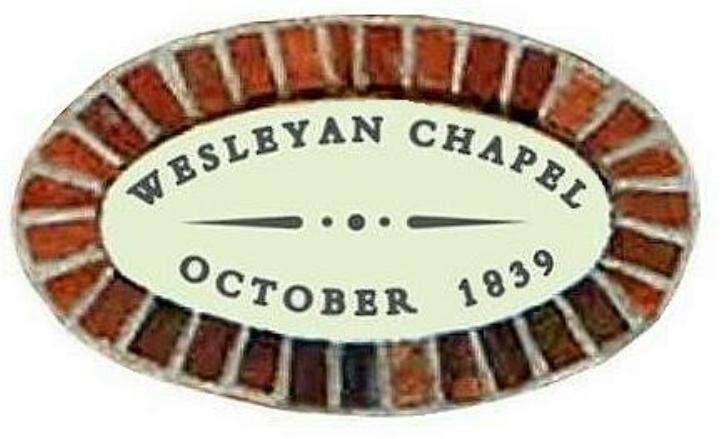
top Maura Benham's biography Home
